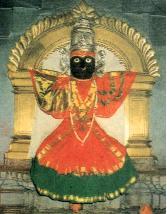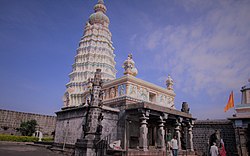| Yamai Devi | |
|---|---|
 | |
| Religion | |
| Affiliation | Hinduism |
 | |
The Yamai Devi Temple is situated in a hill complex in the town of Aundh, Satara district, Maharashtra, India.
| Yamai Devi | |
|---|---|
 | |
| Religion | |
| Affiliation | Hinduism |
 | |
The Yamai Devi Temple is situated in a hill complex in the town of Aundh, Satara district, Maharashtra, India.



It is said that Goddess Mahalaxmi, God Jyotiba of Kolhapur and Sri Rama (Lord Vishnu) called her as "Ye Mai" (in Marathi) (ये माय / ये माई) which means "Mother, pls. come" in English. Hence, she is known as Yamai Devi. Yamai Devi is also considered the elder sister of Tulja Bhavani. Therefore, many devotees still follow the tradition of visiting the Mulpeeth Yamai Devi after visiting Tuljapur's Tulja Bhavani. Devotees are used to come with pure heart into one of the Devi Yamai's temples and to find her blessing. [1]
The Yamai temple is built on a small hill. The top of the hill can either be reached using steps that start at the bottom of the hill, or by car. There is a parking available at the top. The temple complex has the head of Rakshas Aundhasur, a well carved Nandi and a Shivling. The idol of the goddess, Yamai in black stone is almost two metres high and is in a cross-legged sitting position.[ citation needed ] The temple is the family shrine (kula-daiwat) for a large number of Marathi families. The top of the temple has images and idols of various Hindu deities. The town and the temple has been associated with the PantPratinidhi family for many centuries. [2] The present head of this former ruling family, Gayatreedevi Pantpratinidhi, has installed a 7 kilograms (15 lb) solid gold kalash or crown on the pinnacle of the Yamai temple on the hill. Another temple of Devi Yamai is located in the town; apart from the one on the hill. The temple had an elephant for religious processions and ceremonies for more than fifty years. It was taken to an elephant sanctuary in 2017 because of health issues. [3]
The temple complex also houses the Shri Bhavani Museum established from the private collection of the Maharajas of Aundh. The museum building is situated on the middle section of the temple hill. Visitors can reach the museum, both by steps and road. The museum holds paintings by noted 19th and 20th century Indian artists such as M. V. Dhurandhar, [4] Baburao Painter, Madhav Satwalekar [5] and Raja Ravi Varma as well as the famous Mother and Child stone structure by the British artist Henry Moore. [6]
Shri Yamai Devi is revered as one of the prominent goddesses of Maharashtra. Along with the Mulpeeth (original seat) at Aundh, several Uppeethas (subsidiary shrines) dedicated to the goddess have been established across the state for the purpose of destroying evil forces and ensuring the welfare of devotees. These subsidiary shrines are considered as sacred and significant as the original seat. The twelve major Mulpeeth and Uppeethas are as follows:
Major Subsidiary Shrines of Shri Yamai Devi: